Don't wait until Paczki Day (aka Fat Tuesday or Mardis Gras) to enjoy one of these soft traditional Polish donuts filled with jelly, custard, or other delicious fillings! Paczki are homemade jelly donuts are even better than the ones you can get at your favorite local bakery.
If you love donuts, be sure to also check out our Beignets, Classic Apple Cider Donuts, and Old-Fashioned Sour Cream Doughnuts next!

Do you know when is a good time to eat paczki, other than Paczki Day of course? Anytime, that's when. Seriously, these are such a yummy treat that it's sad that they typically only get one short day of glory each year.
Paczki (technically, pączki to use the correct spelling from the Polish alphabet) are pillowy soft, sugar-covered Polish donuts filled with a variety of yummy fillings and are traditionally eaten on Fat Tuesday, which comes before Ash Wednesday and Lent.
In the U.S., we also know this day as Shrove Tuesday, Mardi Gras, or even simply Paczki Day in parts of the country like Michigan where there were large Polish immigrant populations. That's how popular these pastries are among the Polish-American descendants of immigrants who settled in some regions of the country.
I wanted to include paczki to represent one of the most popular foods from Michigan in my American Eats series, where I'm visiting some of the most iconic recipes from each state, one state at a time. Another popular Polish food you might enjoy are these Pierogi, which are little Polish dumplings that I made when I was looking at recipes for Illinois, which also has a large Polish-American population.
These indulgent fried treats were created as a way to use up sugar and lard before the start of Lent. It's pronounced either PONCH-kee, POONCH-kee, or POUNCH-key, but for all my research I couldn't find a consistent phonetic pronunciation so if you are Polish and care to weigh in, please comment below and help me out!
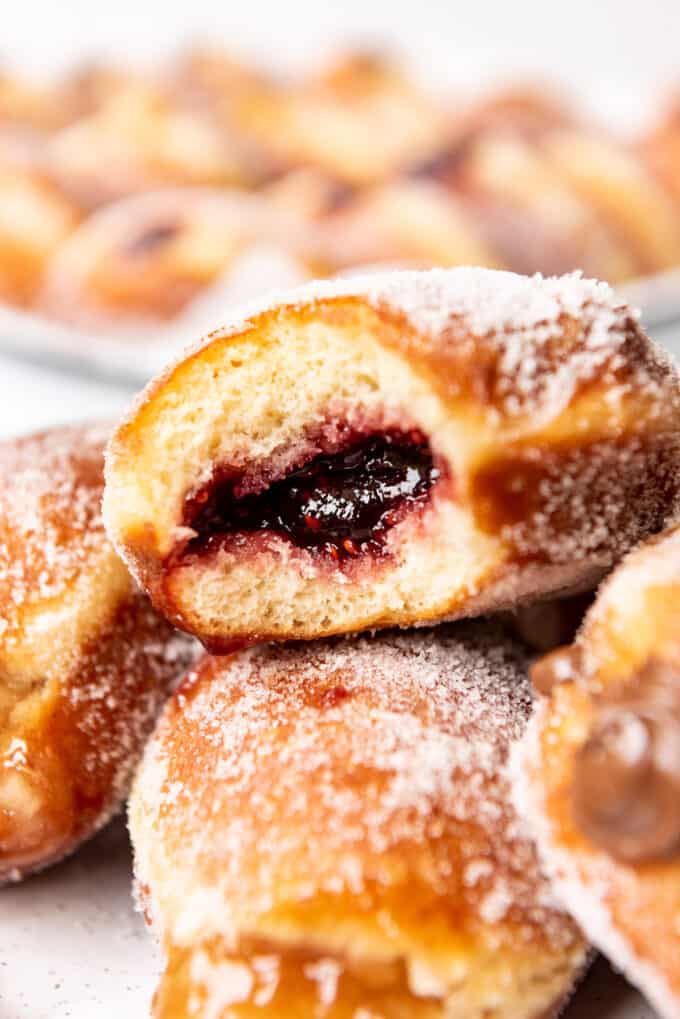
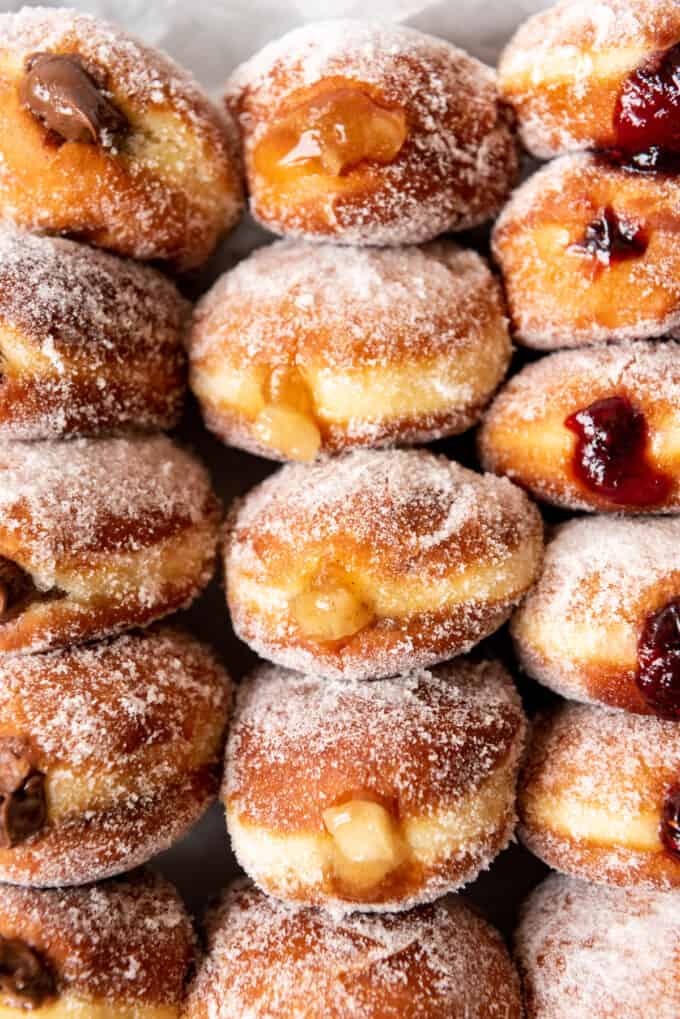
Why this Recipe Works
- Hallmarks of a perfect paczki: Crisp fried exterior and fluffy insides with a pale band around the middle let you know that these were fried at just the right temperature.
- It's an enriched dough, which means it has flour and yeast like you would expect, but also eggs, milk, sugar, and sometimes butter in it for a rich, sweet taste and wonderfully fluffy texture.
- Traditionally in Poland they are filled with wild rose hip jam or a stewed plum jam, but the sky is really the limit when it comes to filling ideas. Using store bought filling makes these easy to offer a variety.
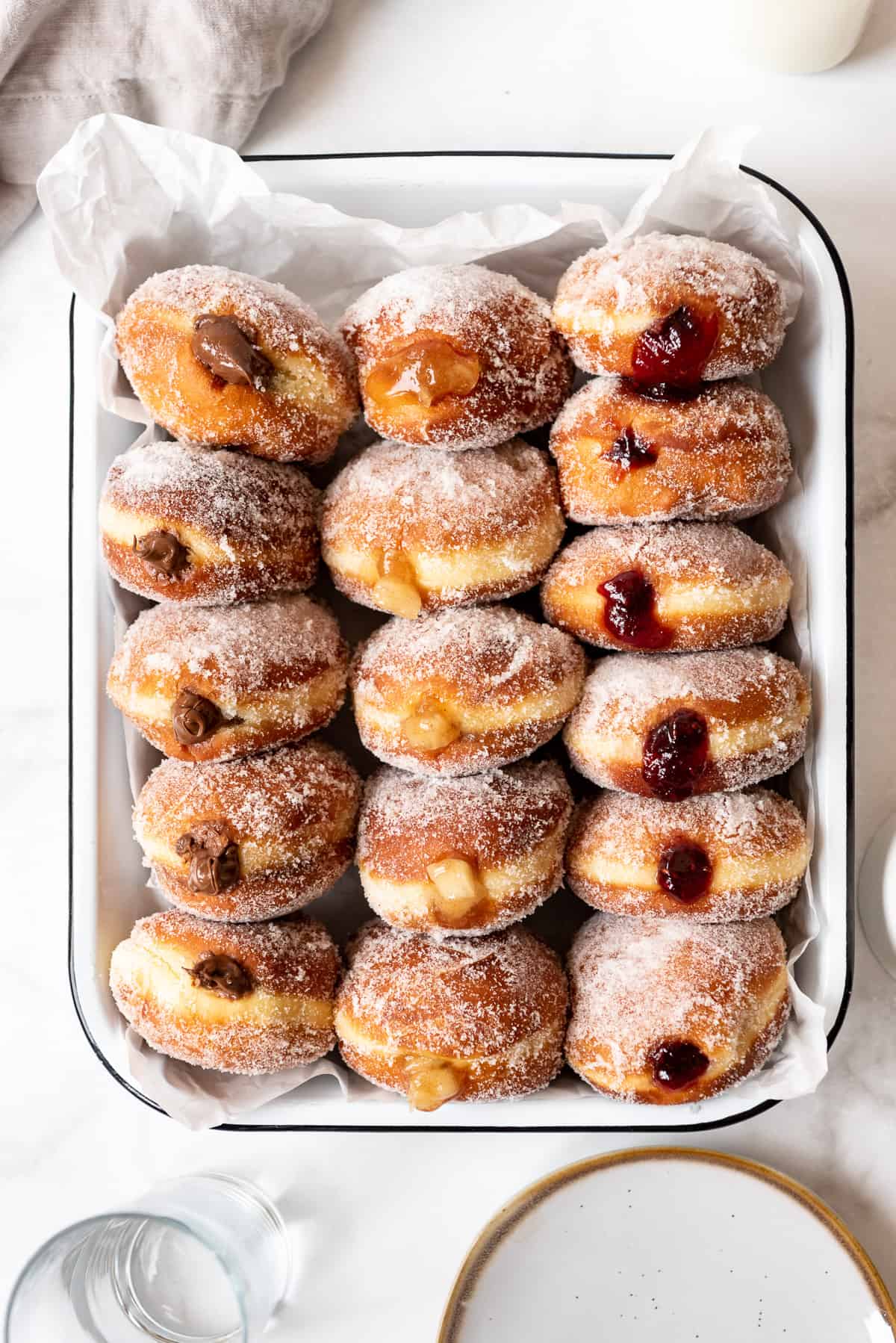
Ingredient Notes
- Eggs: You will use one whole egg and three egg yolks for an extra rich dough.
- Yeast: I used active dry yeast, which means it requires proofing in some warm water with a little sugar to wake up the yeast before you can use it in the recipe. If you have instant yeast, you can use that instead and skip the proofing step.
- Butter: Melted butter adds wonderful flavor and richness to this recipe, but oil will work as well.
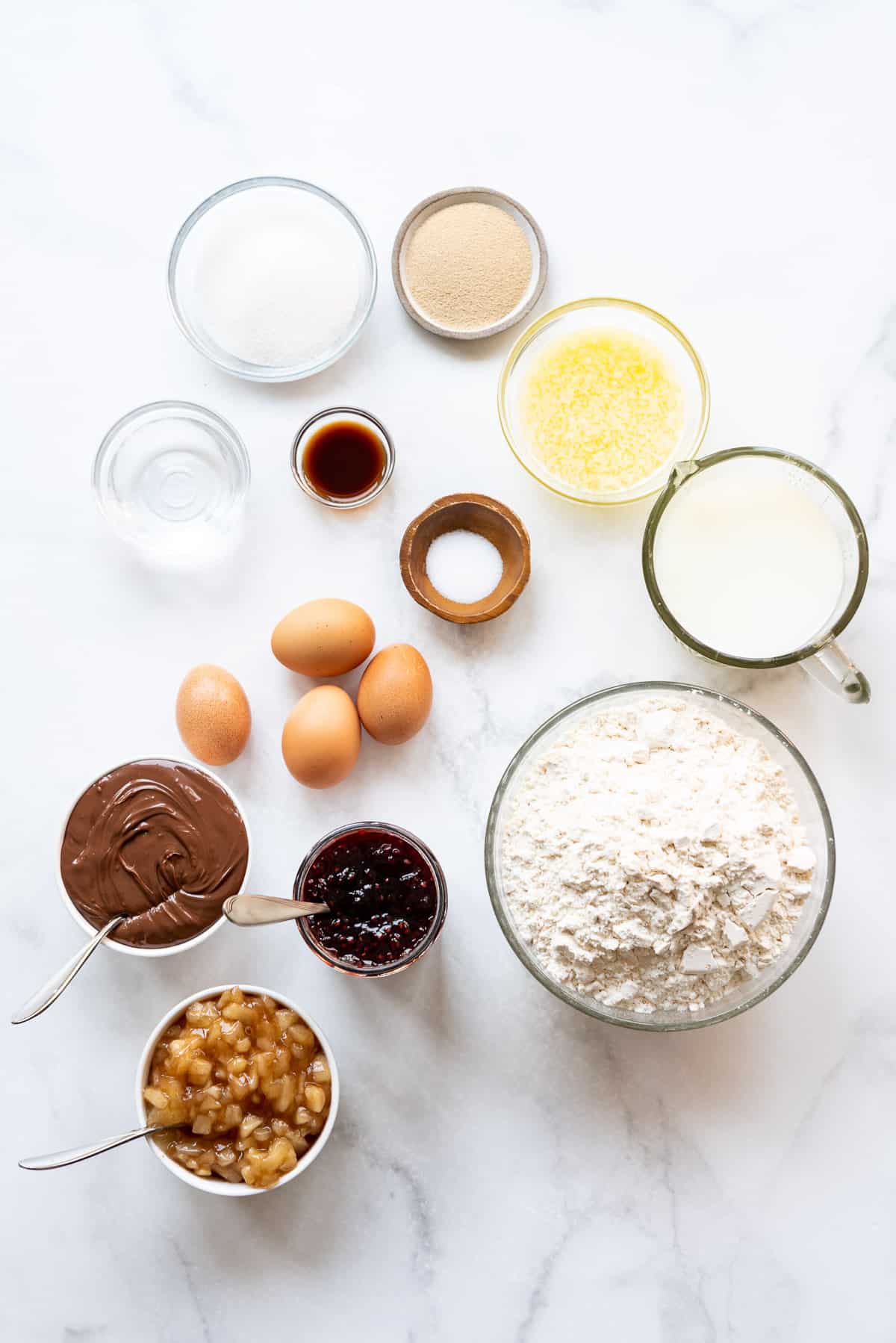
How to Make This Recipe
Start by proofing the yeast in warm water with 1 tablespoon of the sugar. After about 5 minutes, it should be bubbly and foamy and ready to go.
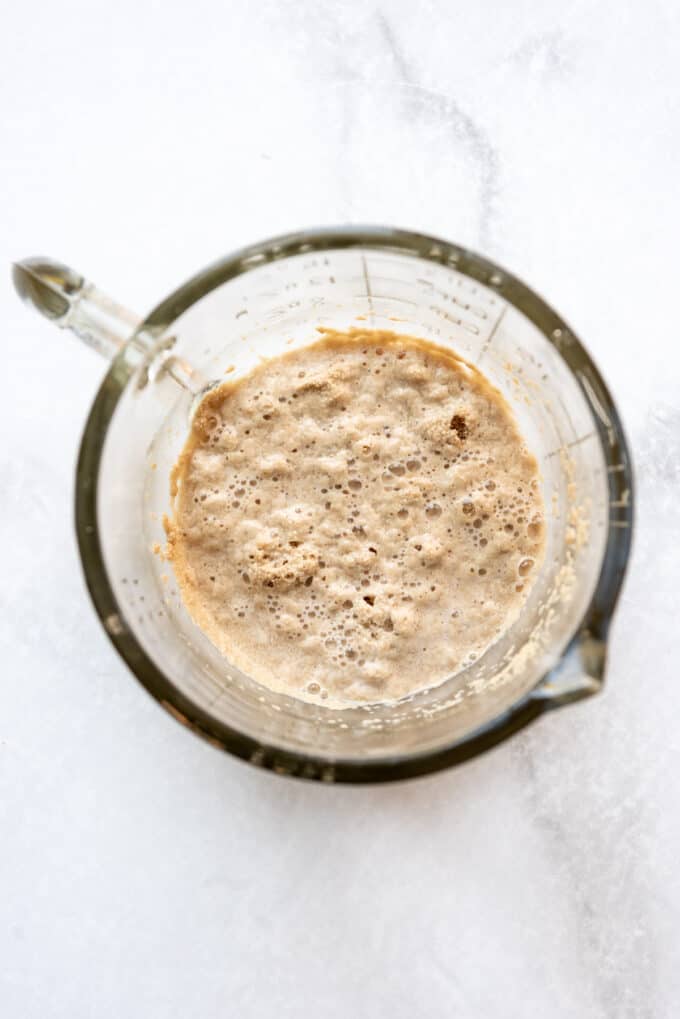
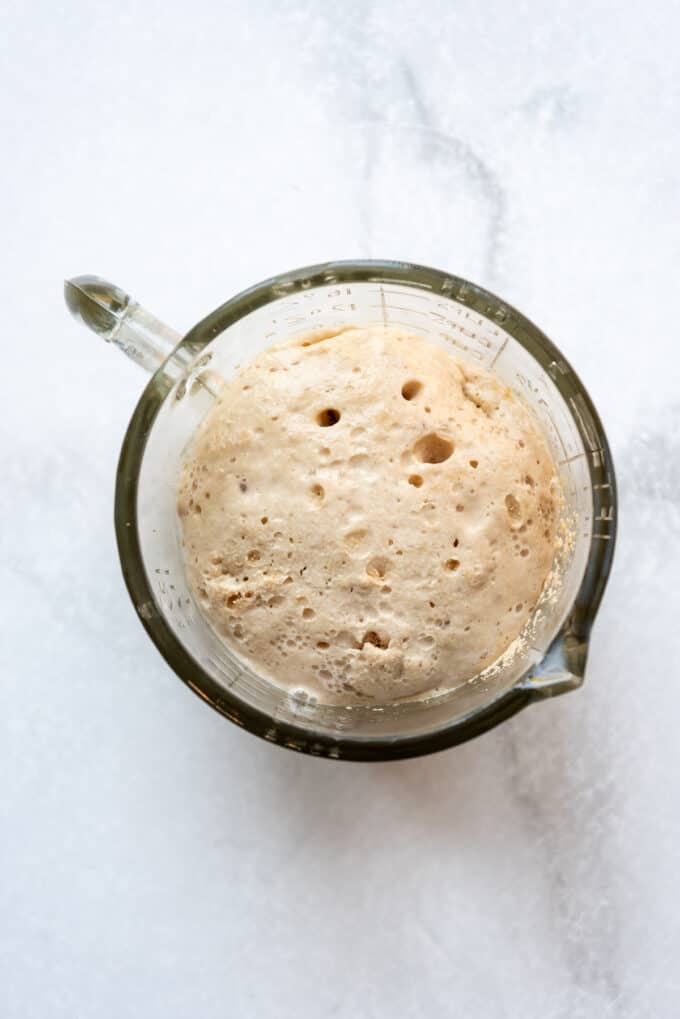
In a large mixing bowl, add milk, remaining sugar, melted butter, egg, egg yolks, salt, and vanilla extract. Mix to combine, then add the proofed yeast and 2 cups of the flour. Beat well with the paddle attachment until smooth.
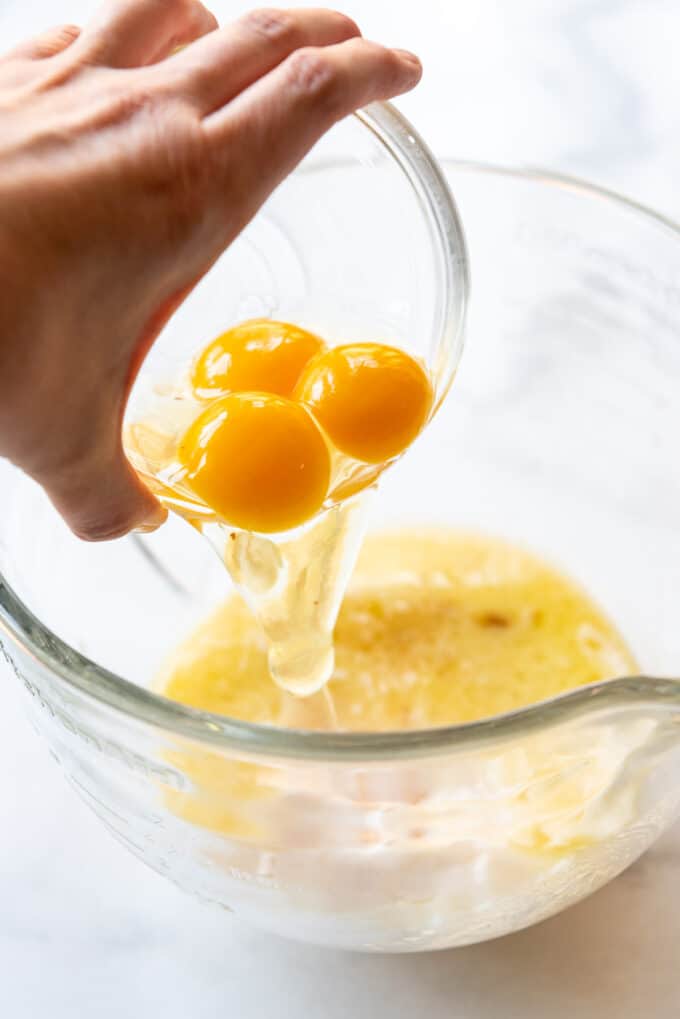
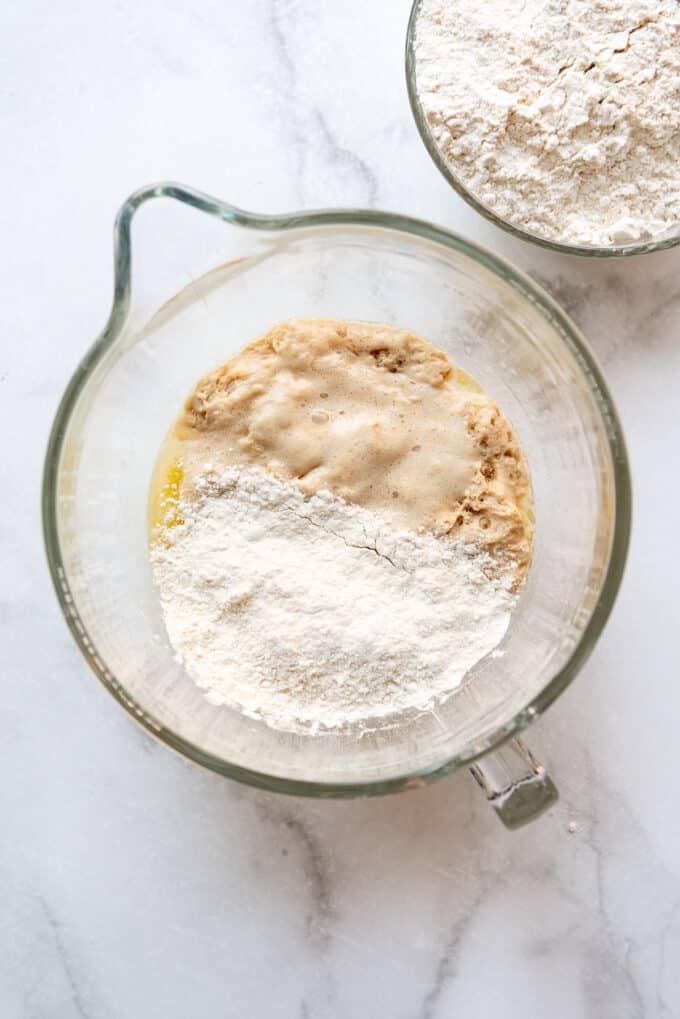
Switch to the dough hook and add the remaining flour 1 cup at a time. Once the flour has been added, continue to knead with with the dough hook on medium-low speed for about 5 minutes. The dough should start to clean off the side of the bowl but still be very soft. If it's still sticking, you can add more flour, about ½ cup at a time, until you get a workable consistency, but keep in mind that this will be a fairly stick, soft dough.
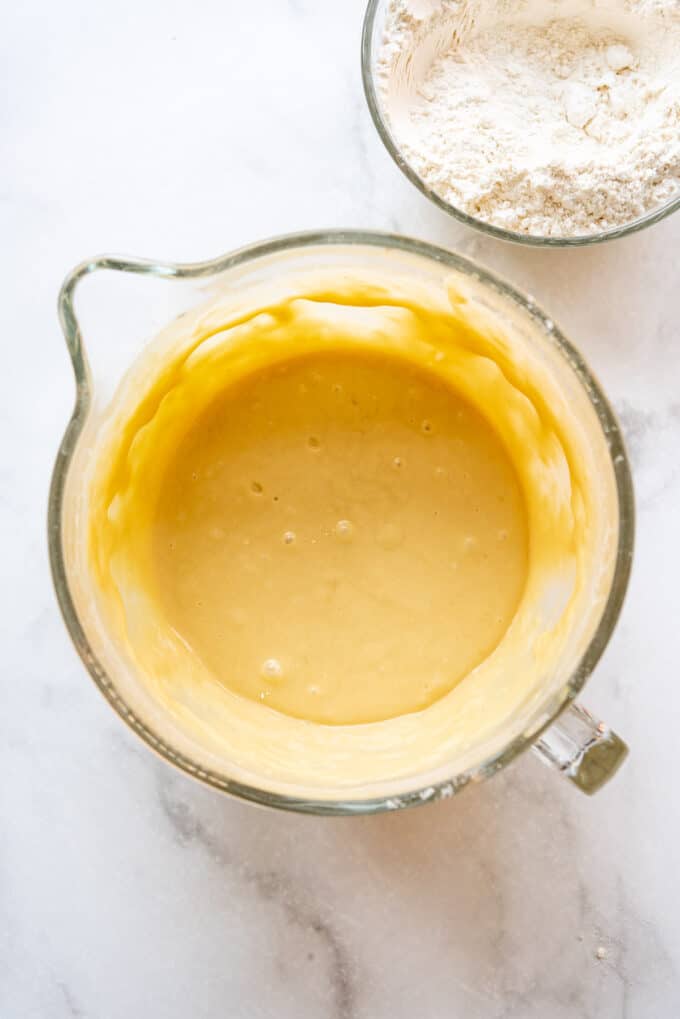
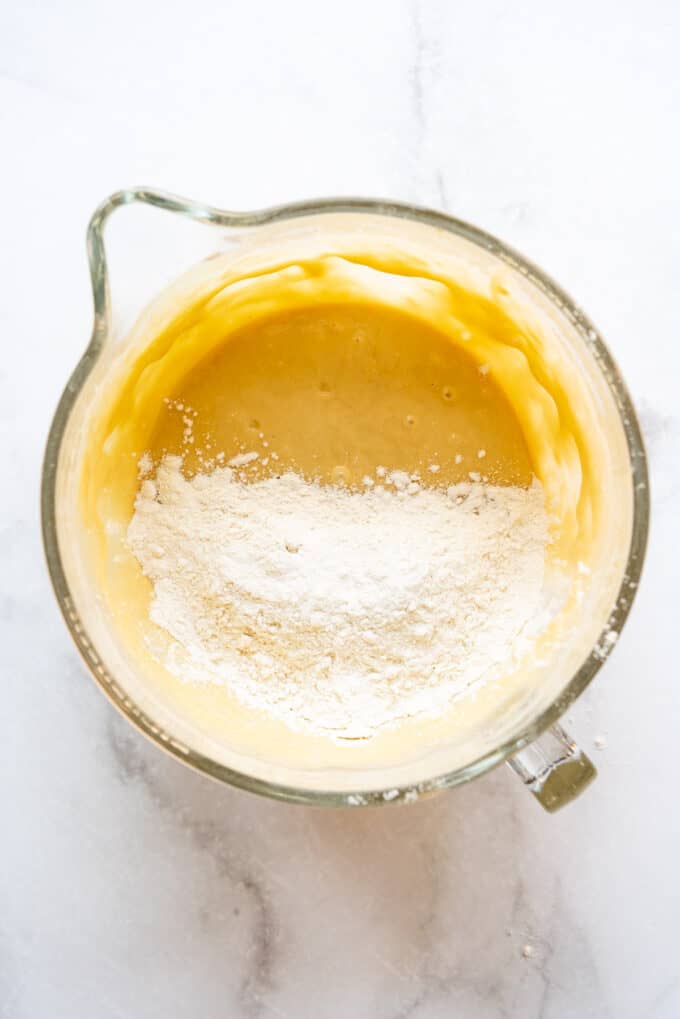
Transfer the dough to a lightly greased bowl and cover with plastic wrap. Let it rise in a warm spot until doubled in size, around 1-2 hours. Enriched dough usually takes a bit longer to rise because ingredients like butter and egg yolks slow the process and weigh down the dough a bit.
See recipe notes for info on doing an overnight rise, if you want to make these ahead for easy breakfast prep.
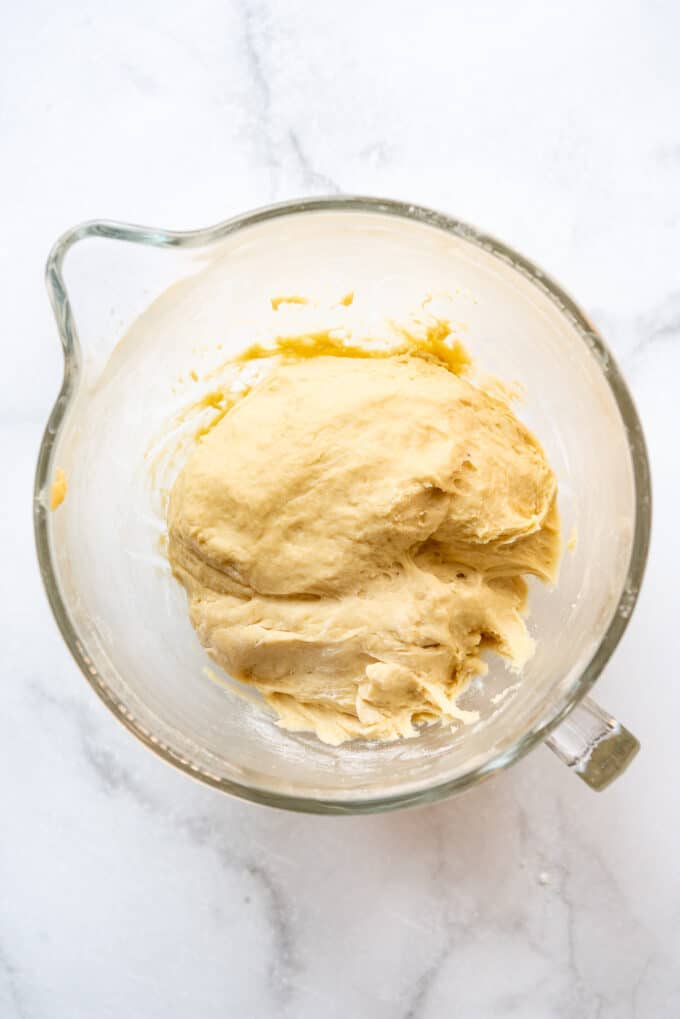
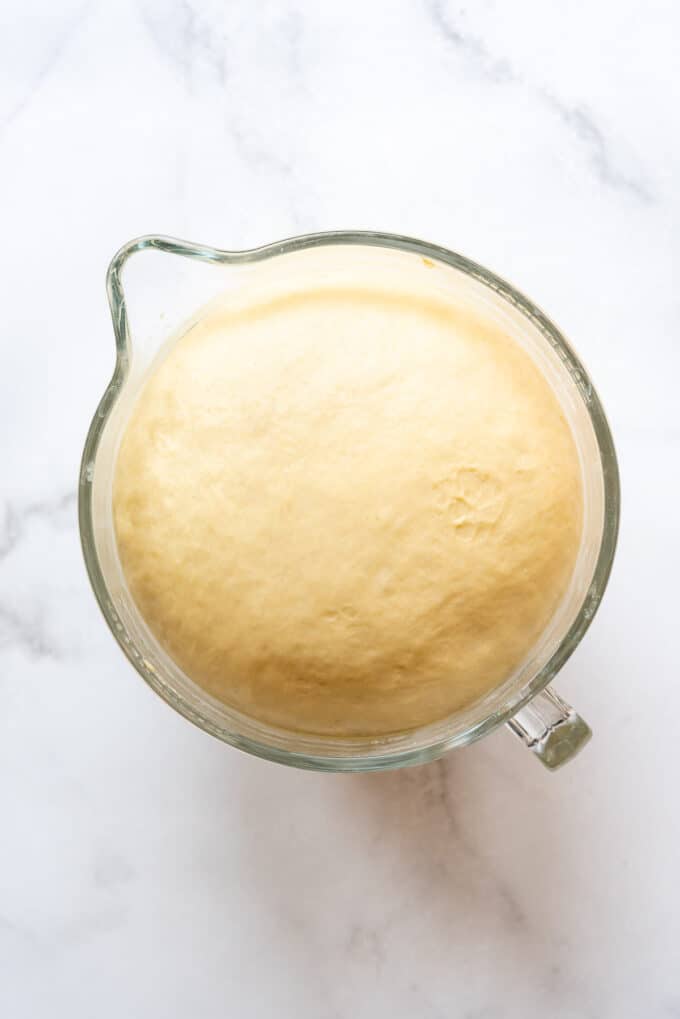
Once the dough has risen, roll it out on lightly floured surface to about ½-inch thick. Use a 3- or 3 ½-inch biscuit or donut cutter (even a lid or glass will work) to cut out circles of dough and transfer them to baking sheets lined with parchment paper leaving space between them to rise. Dip the cutter into flour between each cut to help prevent it from sticking to the dough.
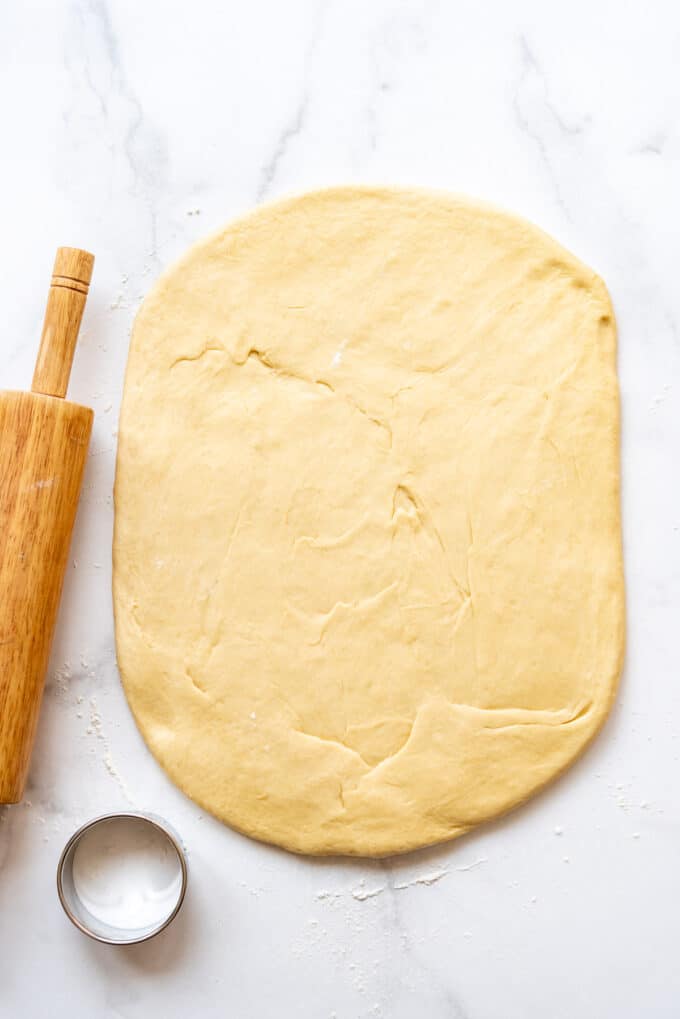
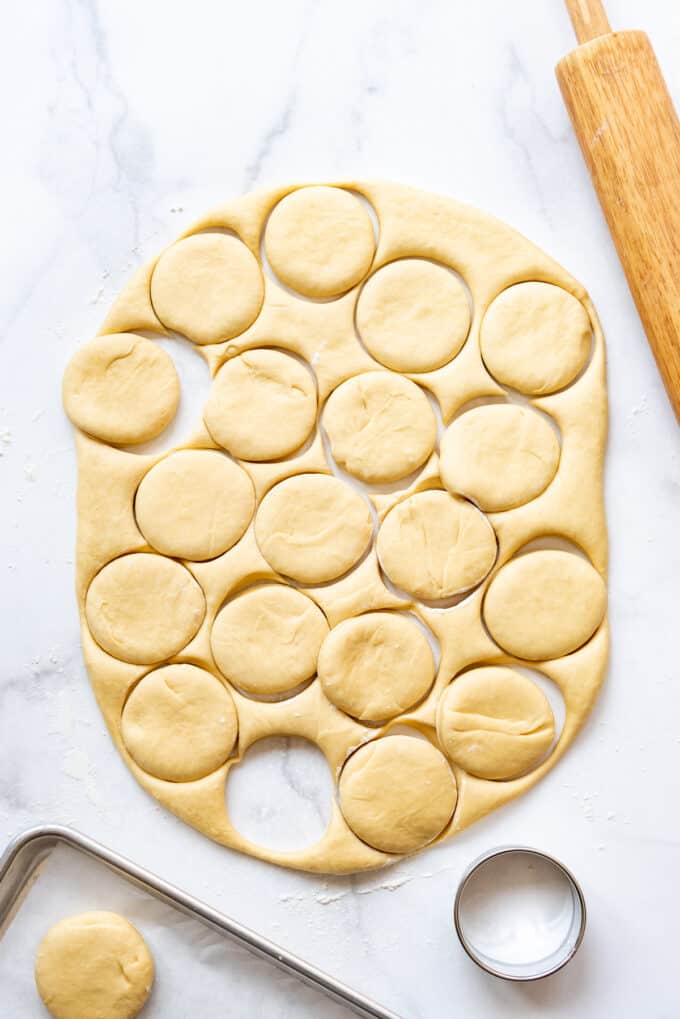
Cover the paczki dough and let them rise for 30-60 minutes in a warm spot until puffy and doubled in size.
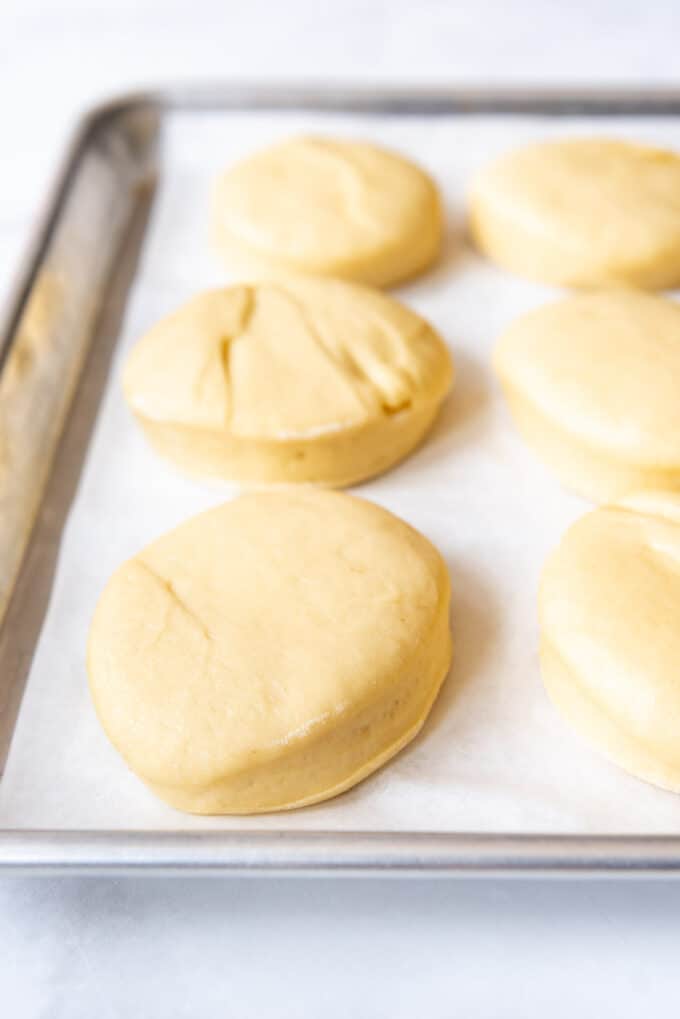
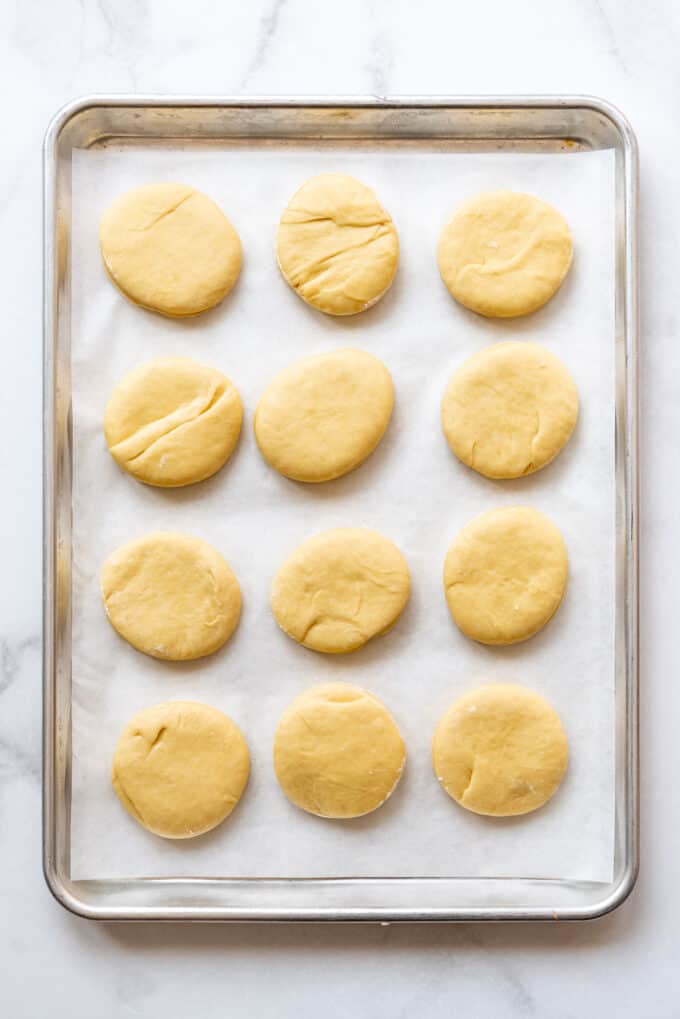
Heat about 3 inches of oil over medium heat in a large cast iron skillet to 325 to 350°F. Fry 3-5 donuts at a time for 2-3 minutes on one side, then flip and fry for another 1-2 minutes on the second side until golden brown with a white stripe around the middle.
Use a digital thermometer to monitor the oil temperature while frying and adjust the heat of the stove to keep it between 325 and 350 degrees F. Work in batches so you don't drop the temperature of the oil too much when you add fresh dough circles to it.
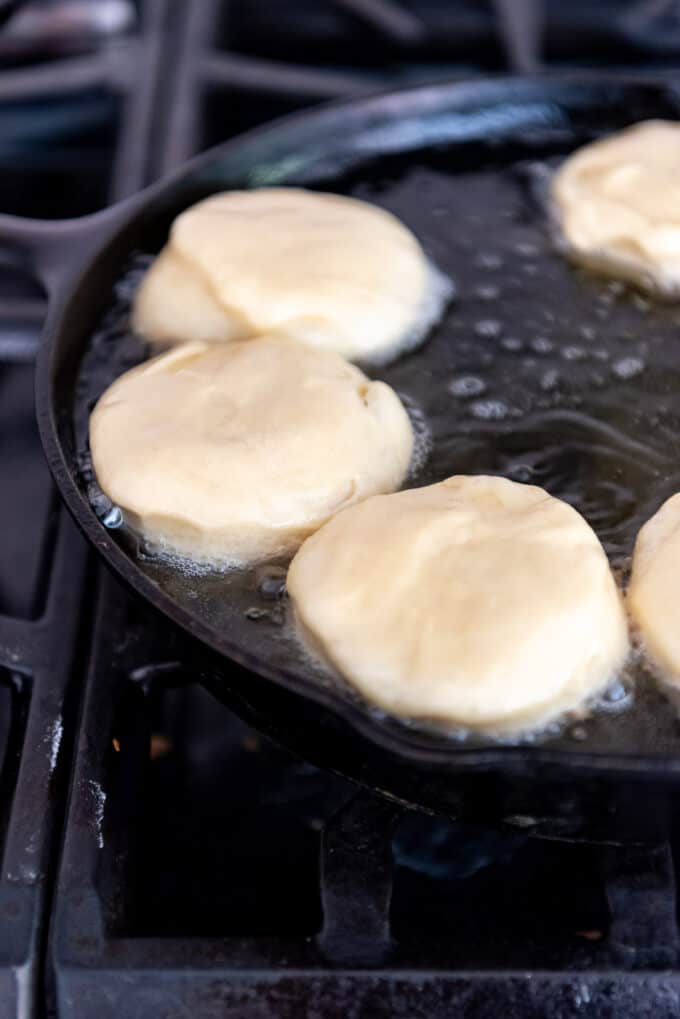

Once the paczki are golden brown on both sides with a pale stripe around their middles, use a wire slotted spoon to move them from the hot oil. Drain excess oil on paper towels, then toss them in granulated sugar while still hot. Or if you want to coat them in powdered sugar, let them cool completely first so the powdered sugar doesn't melt from the hot donuts.
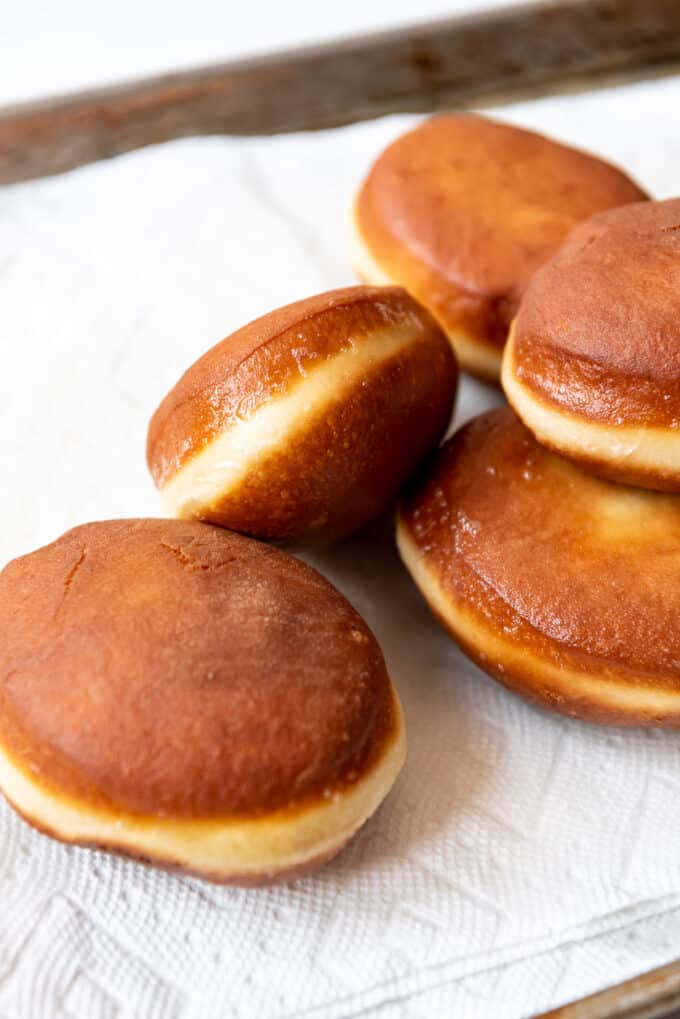
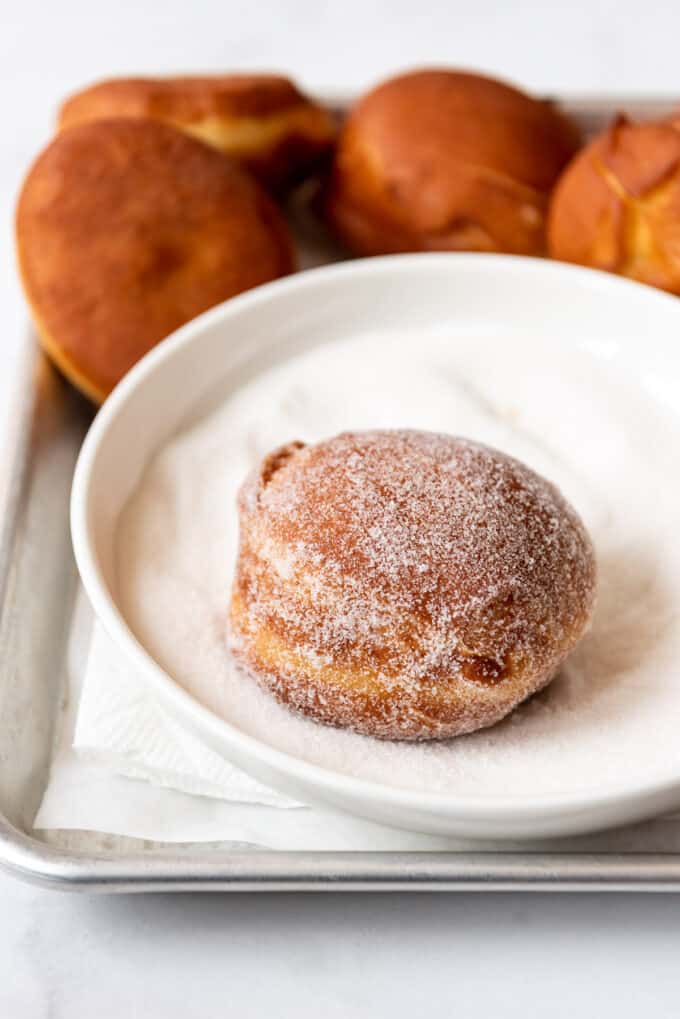
Fit a piping bag with an open piping tip and fill with your filling of choice. Stick the piping tip into the side of a paczki and squeeze until the filling starts to pool at the top. If you have a hard time getting your piping bag into the side of your paczki you can make a slit with a knife to get things started.
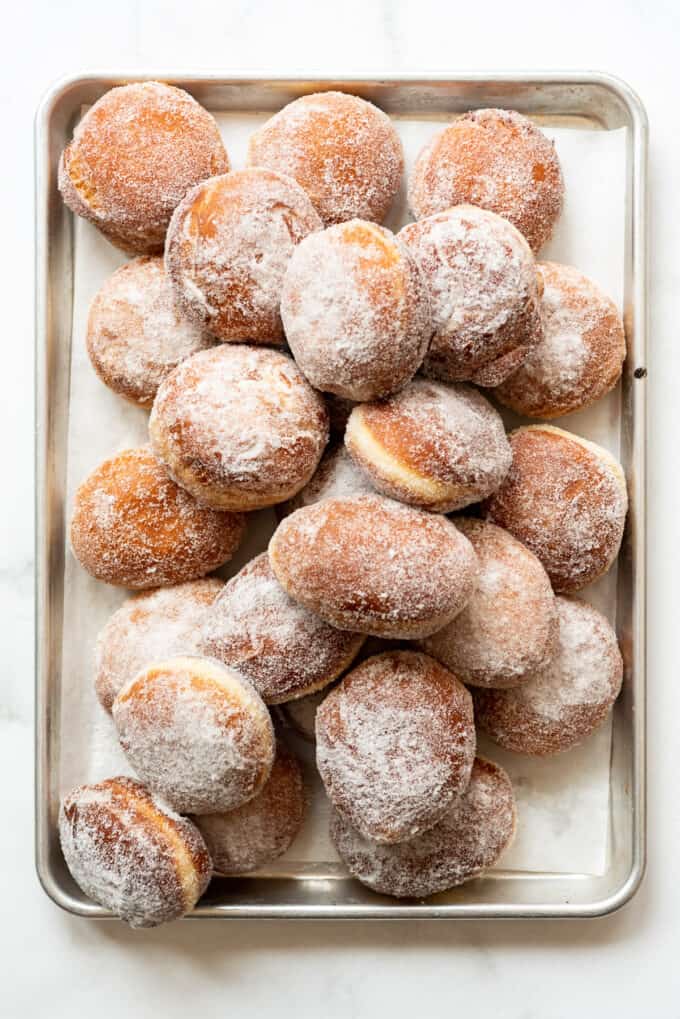
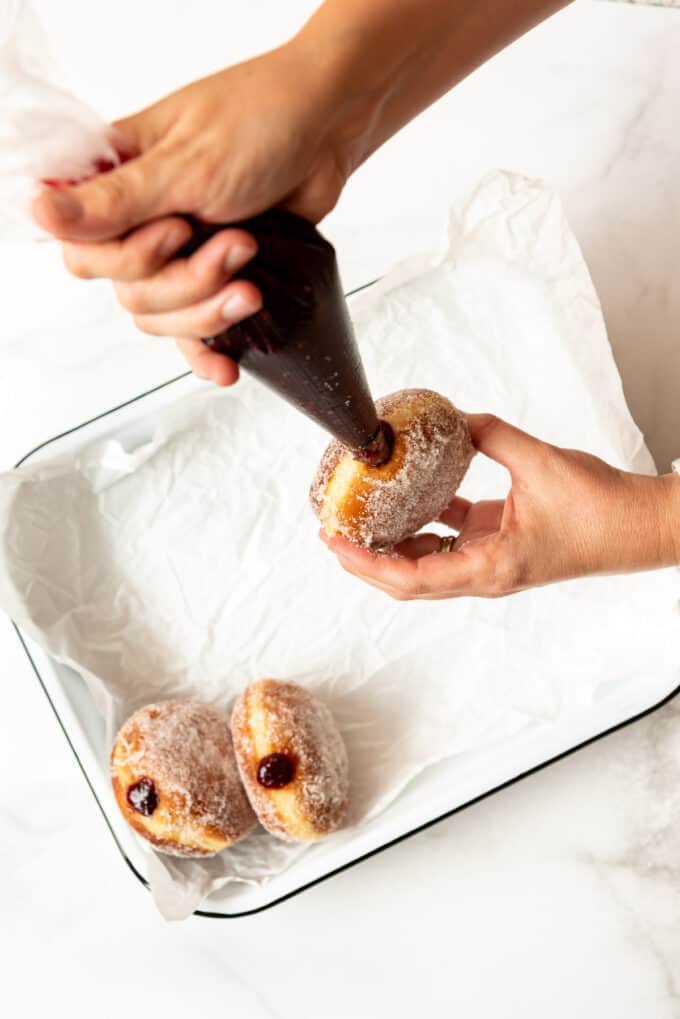
It's best to store the filled paczki upright with the filling at the top so it doesn't leak out. They can be kind of messy to eat, but it is so worth it!
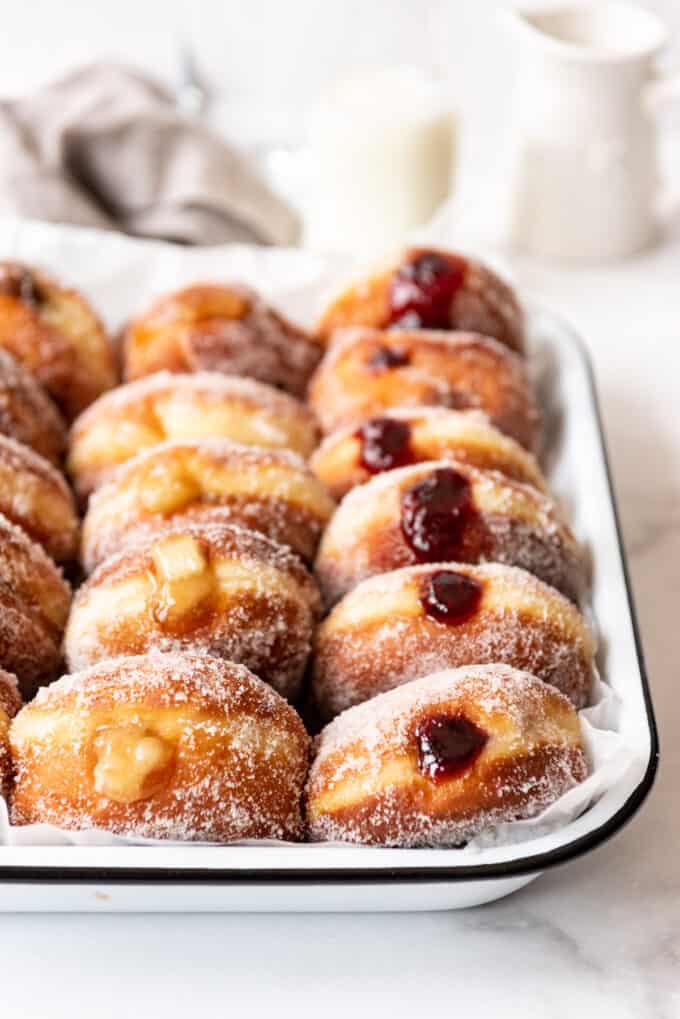
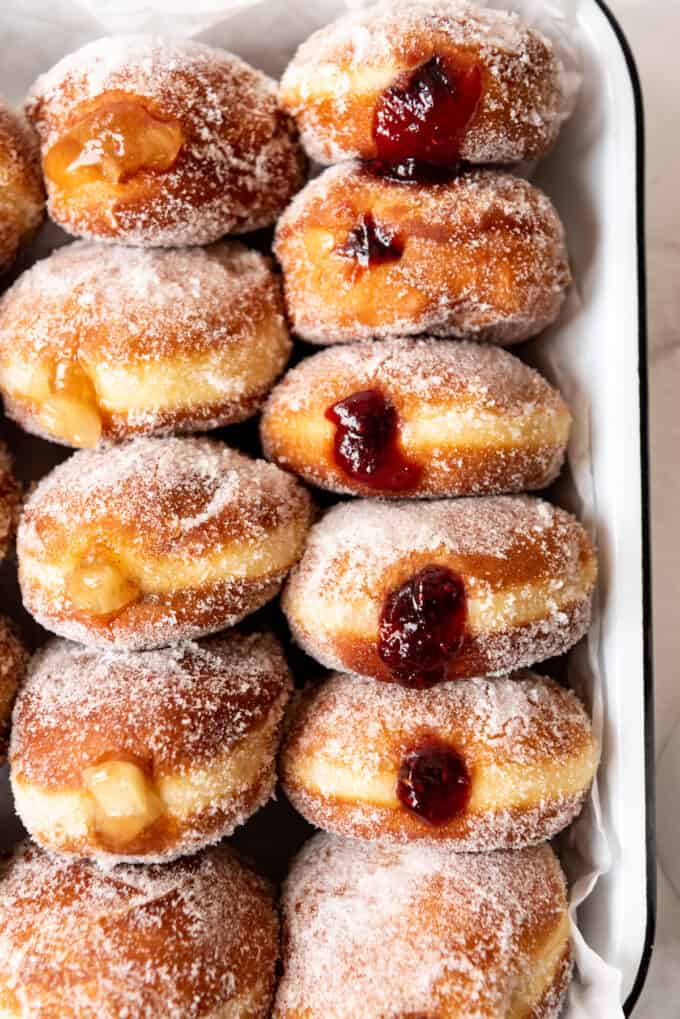
Recipe FAQ's
Paczki are pretty similar to the jelly filled yeasted donuts you get at a donut shop, although the dough itself is slightly sweeter. But they differ from most donuts that have holes in the center. The dough is also a bit richer and chewier than a traditional donut.
Yes, but really these are best fresh! If you want to freeze them, I recommend waiting to coat them in sugar and fill with filling. When you want to enjoy a fresh-tasting paczki, just thaw as many of them as you like, then dust with powdered sugar (which sticks better on the previously frozen donuts) and fill with your desired fillings. You can even warm the thawed paczki before filling them by popping them in the oven, air fryer, or microwave for a bit to fresh them up.
You can certainly make the dough the night before so that it's ready to fry in the morning. Just knead the dough, the cover with plastic wrap and stick it in the fridge for a long, slow rise overnight. It's actually a great idea since the flavor of the dough develops more over time. Pull the dough out in the morning and let it come to room temperature before rolling out and cutting into circles for the last rise.
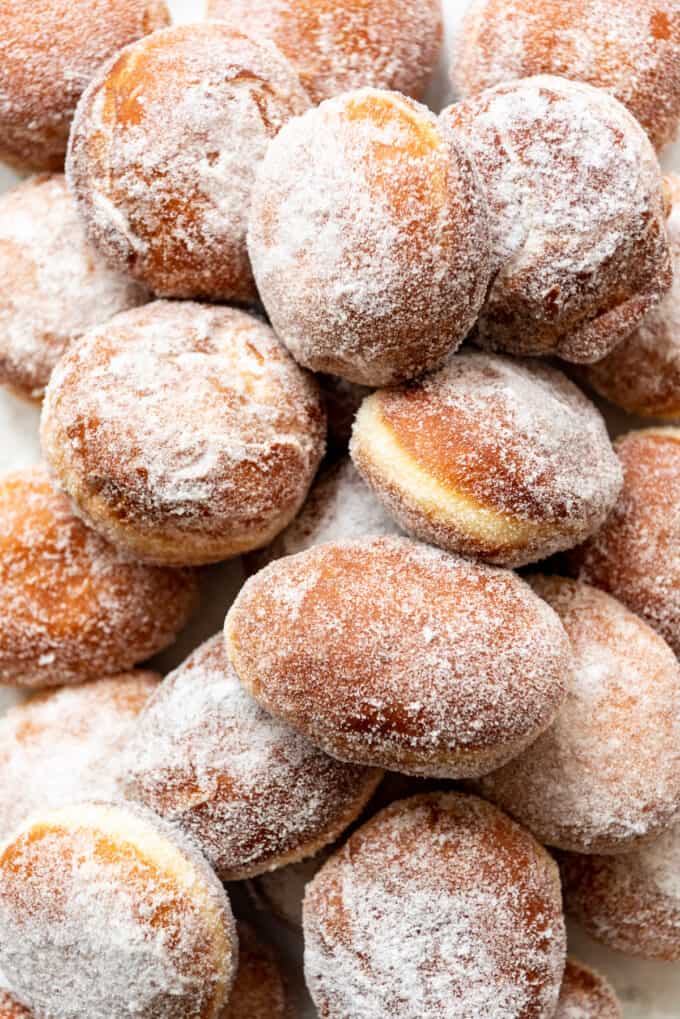
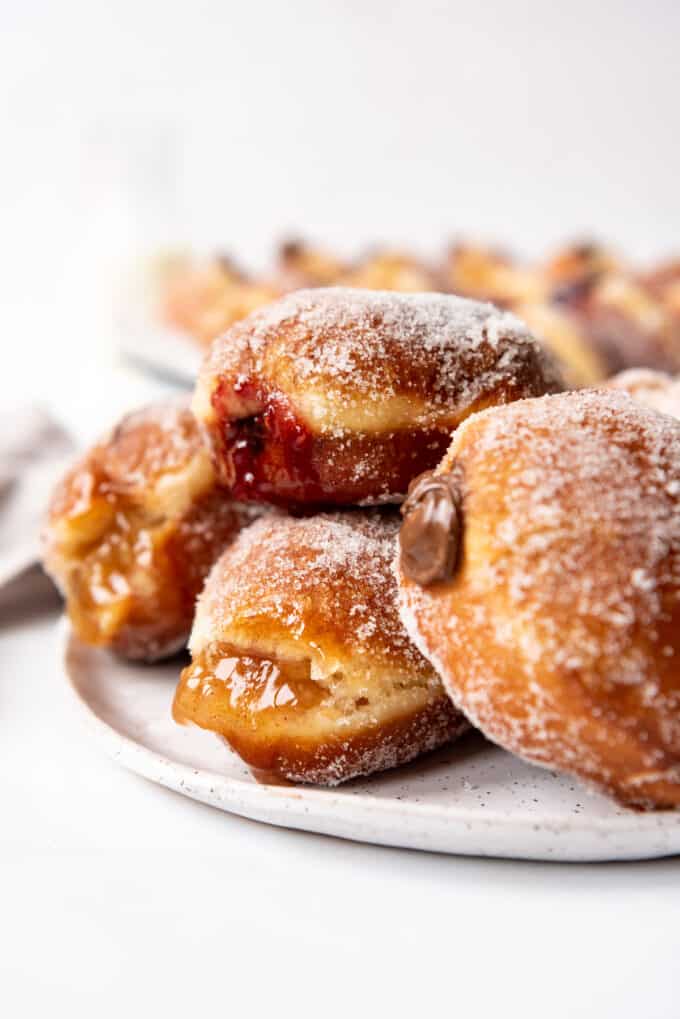
Recipe Tips
- Storage: These delicious fried treats are most definitely best served fresh and warm, just out of the fryer. We recommend eating them the day they are made, although they can last for a day or two on the counter.
- Frying tips: Use a good digital thermometer or candy thermometer (affiliate link) clipped to the side of the pan to monitor the temperature of your oil for even frying. If the oil gets too hot, you risk burning the outside of your donuts while the insides are still doughy. If the oil is not hot enough, the donuts will soak up too much of the oil and be greasy. You are shooting for oil temperature of between 325 and 350°F, and it should only take 2-3 minutes per side to fry the donuts.
- Halving the recipe: The recipe makes 16-20 paczki, which is quite a few so we usually share with friends since they are best fresh. But if you want to halve the recipe, just use 1 egg + 1 egg yolk, rather than trying to mess around with halving one whole egg.
- These can be glazed or coated with powdered sugar or granulated sugar. Also, they can be served unfilled, if that's what you prefer. Although I like them filled best.
- Powdered sugar vs. granulated sugar: Both area delicious, although I like the sparkle and crunch of the granulated sugar. Roll the paczki in the granulated sugar while they are still hot from being fried so that the sugar can stick best. If you choose to coat your paczki with powdered sugar instead, wait until they have cooled completely from frying before dusting them so the powdered sugar doesn't melt.
- Filling ideas: Paczki can be filled with any fruit jam like raspberry, strawberry, blueberry, peach, apricot, or plum. I used some apple pie filling and chopped the apple pieces small to fill some of these paczki. Or any kind of creamy custard, pastry cream, or chocolate pudding fillings would be good.
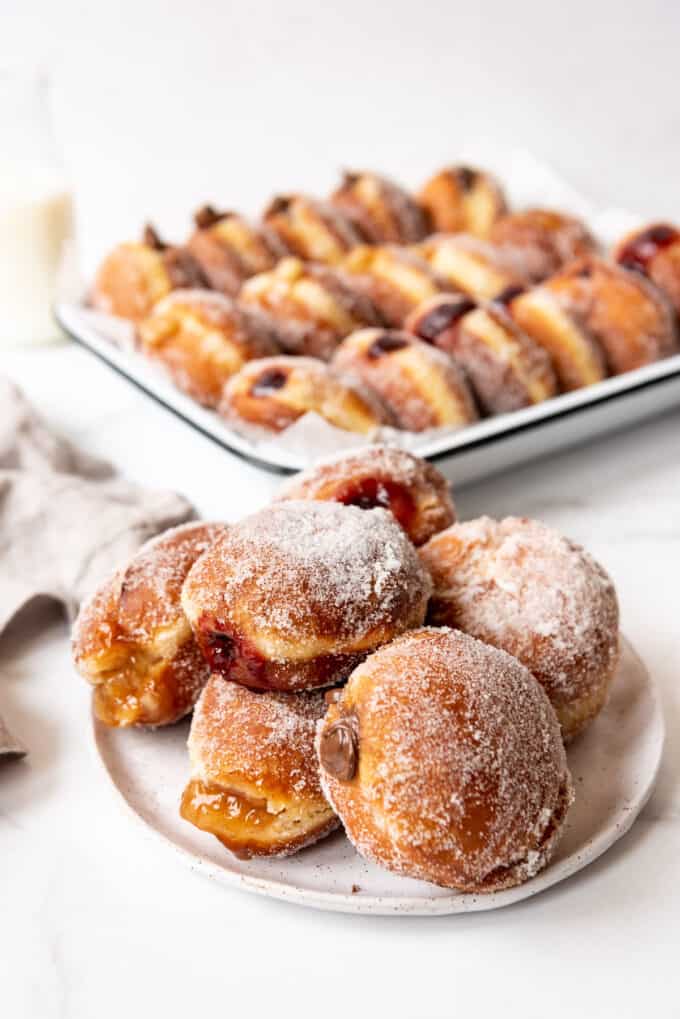
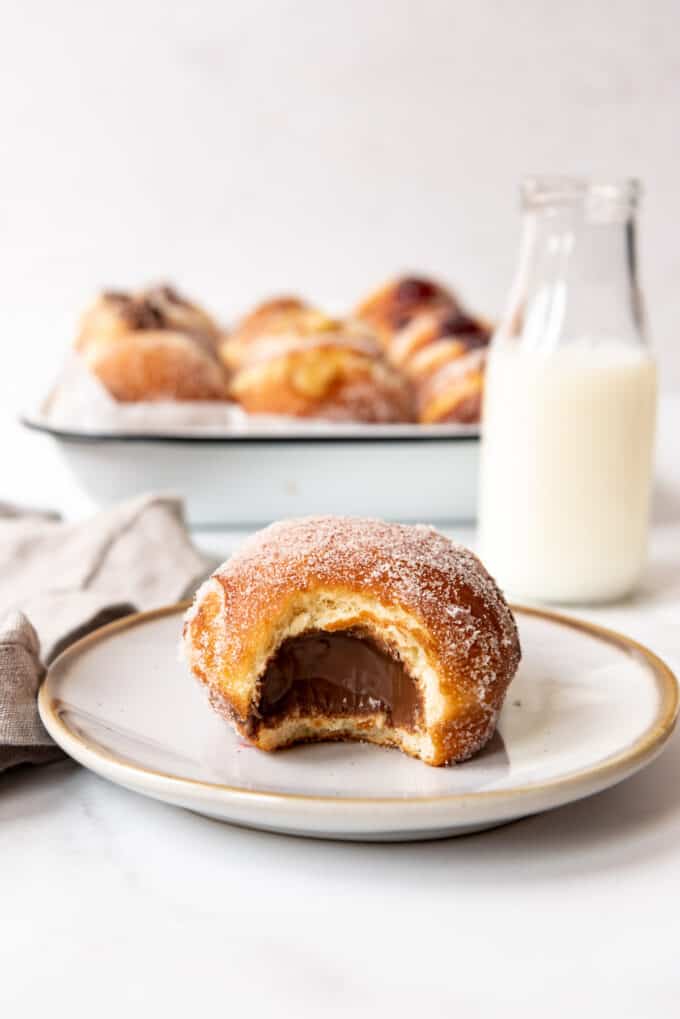
More Recipes Like This
- Easy Classic French Cream Puffs
- Classic Homemade Eclairs
- Whoopie Pies (Gobs)
- Cinnamon Sugar Twist Doughnuts
Did you make this recipe?
Let me know what you thought with a comment and rating below. You can also take a picture and tag me on Instagram @houseofnasheats or share it on the Pinterest pin so I can see.
Paczki (Jelly Donuts)
Ingredients
- ¼ cup warm water (between 100 and 110°F)
- 4 ½ teaspoons active dry yeast
- ½ cup granulated sugar, divided (100g)
- 1 ½ cups whole milk, warm
- ½ cup salted butter, melted
- 1 egg
- 3 egg yolks
- 1 teaspoon vanilla extract
- 1 teaspoon salt
- 5 to 5 ½ cups all-purpose flour, scooped and leveled (705 to 776g)
- Canola oil, for frying (or vegetable or peanut oil)
- Additional granulated sugar, for coating the outside of the donuts
- Raspberry jam, Nutella, apple pie filling, lemon curd, pastry cream, etc., for filling
Instructions
- Combine the yeast, warm water, and 1 tablespoon of the sugar in a bowl. Let it sit for 5-10 minute until foamy to proof. When bubbly, add eggs, butter, salt, and vanilla.
- In a large mixing bowl, combine the remaining sugar, warm milk, butter, egg, egg yolks, vanilla, and salt. Add the proofed yeast and 2 cups of the flour, then beat using the paddle attachment for 1-2 minutes until smooth.
- Switch to the dough hook and continue to add the remaining flour, 1 cup at a time, kneading between additions. Once the flour has been added, knead on medium-low speed for about 5 minutes until smooth. The dough will be sticky and soft, but should start to clean off the side of the bowl. You can also knead by hand for 7-9 minutes on a lightly floured surface instead. If the dough is really sticking to the bowl, you can add a little more flour, ½ cup at a time, until the dough is workable. But for the lightest paczki, try not to add too much flour.
- Transfer the paczki dough to a clean, lightly greased bowl. Cover with plastic wrap and let rise in a warm place until doubled in size, about 1-2 hours or in the fridge overnight.
- Turn out dough onto a lightly floured surface and roll out to about ½-inch thick. Use a 3- to 3 ½-inch round biscuit or donut cutter (or cup or lid about that size) to cut out rounds, then place them on baking sheets lined with parchment paper with space between them to rise. You may need to dip the cutter into flour between each cut so it doesn't stick to the dough.
- Cover the circles of dough loosely with plastic wrap and let them rise for 30-60 minutes until puffy and doubled in size. Or place them in the fridge for a slow proof overnight so they are ready to fry in the morning.
- Heat about 3 inches of oil over medium heat in a large cast iron skillet to 325 to 350°F. Fry 3-5 donuts at a time for 2-3 minutes on one side, then flip and fry for another 1-2 minutes on the second side until golden brown with a pale stripe around the middle.
- Transfer the fried paczki to a paper towel-lined baking sheet with a wire slotted spoon to drain excess oil. Toss in granulated sugar while still hot. Or let cool completely, then roll or dust in powdered sugar.
- Fit a piping bag fitted with an open piping tip and fill with your filling of choice. Stick the piping tip into the side of a donut and squeeze until the filling starts to pool at the top of the donut. If you have a hard time getting your piping bag into the side of your paczki you can make a slit with a knife to get things started.
- Serve immediately for best results, or store upright at room temperature for up to 2 days.
Notes
- Halving the recipe: The recipe makes 16-20 paczki, which is quite a few so we usually share with friends since they are best fresh. But if you want to halve the recipe, just use 1 egg + 1 egg yolk, rather than trying to mess around with halving one whole egg.
- Variations: These can be glazed or coated with powdered sugar or granulated sugar. Also, they can be served unfilled, if that's what you prefer. Although I like them filled best.
- Powdered sugar vs. granulated sugar: Both area delicious, although I like the sparkle and crunch of the granulated sugar. Roll the paczki in the granulated sugar while they are still hot from being fried so that the sugar can stick best. If you choose to coat your paczki with powdered sugar instead, wait until they have cooled completely from frying before dusting them so the powdered sugar doesn't melt.
- Filling ideas: Paczki can be filled with any fruit jam like raspberry, strawberry, blueberry, peach, apricot, or plum. I used some apple pie filling and chopped the apple pieces small to fill some of these paczki. Or any kind of creamy custard, pastry cream, dulce de leche, or chocolate pudding fillings would be good.
- Freezing: If you want to freeze them, I recommend waiting to coat them in sugar and fill with filling. When you want to enjoy a fresh-tasting paczki, just thaw as many of them as you like, then dust with powdered sugar (which sticks better on the previously frozen donuts) and fill with your desired fillings. You can even warm the thawed paczki before filling them by popping them in the oven, air fryer, or microwave for a bit to fresh them up.
- Overnight rise: You can make the dough the night before so that it's ready to fry in the morning. You can refrigerate the dough before the first rise, then shape the paczki in the morning, or go ahead and shape them the night before and refrigerate them at that point. Either way, cover the dough with plastic wrap so it doesn't dry out. An overnight rise is a great idea since the flavor of the dough develops more over time.
Nutrition
More States I Have Visited in my American Eats Series
Alabama • Alaska • Arizona • Arkansas • California • Colorado • Connecticut • Delaware • Florida • Georgia • Hawaii • Idaho • Illinois • Indiana • Iowa • Kansas • Kentucky • Louisiana • Maine • Maryland • Massachusetts • Michigan • Minnesota • Mississippi • Missouri • Montana • Nebraska • New Jersey • New York • Oregon • Puerto Rico • South Carolina • South Dakota • Texas • Utah • Wisconsin
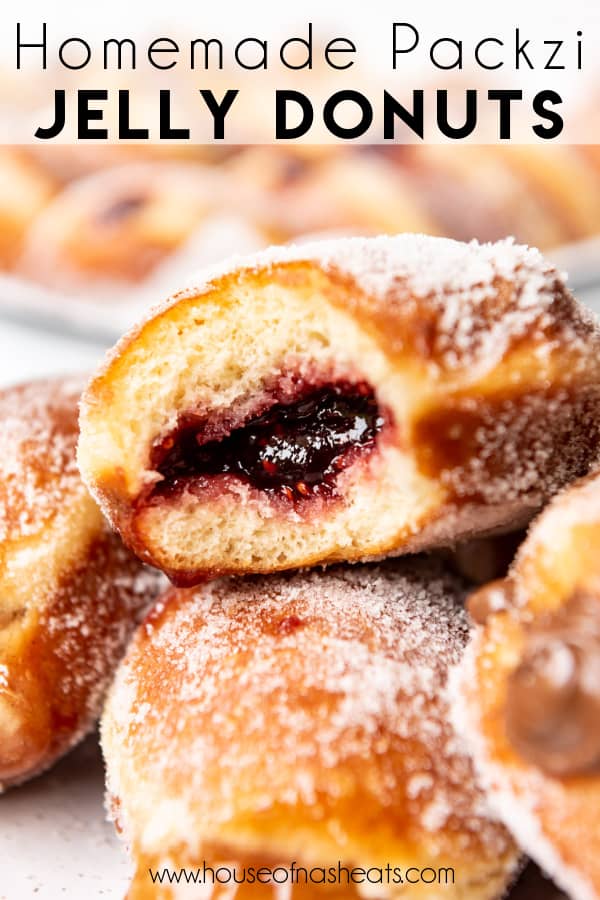

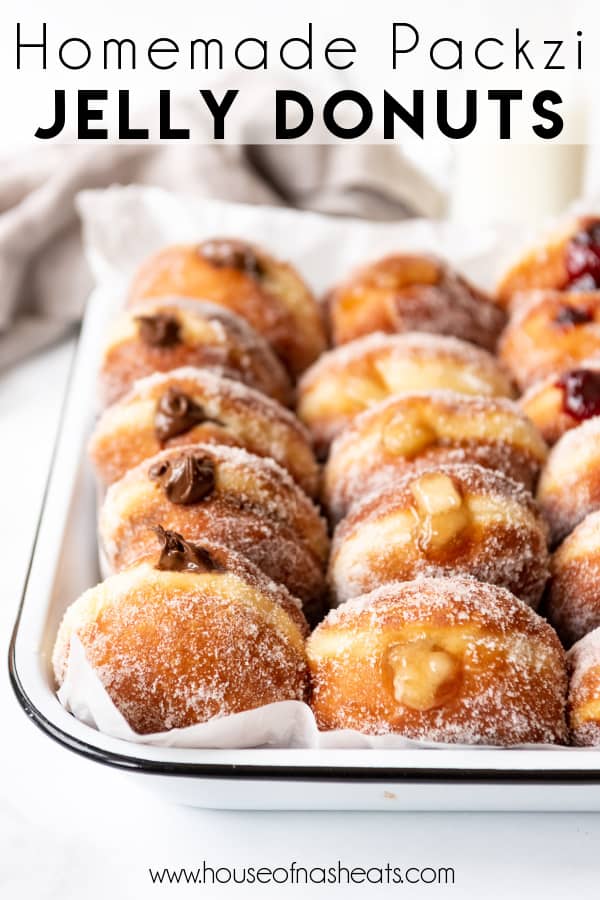
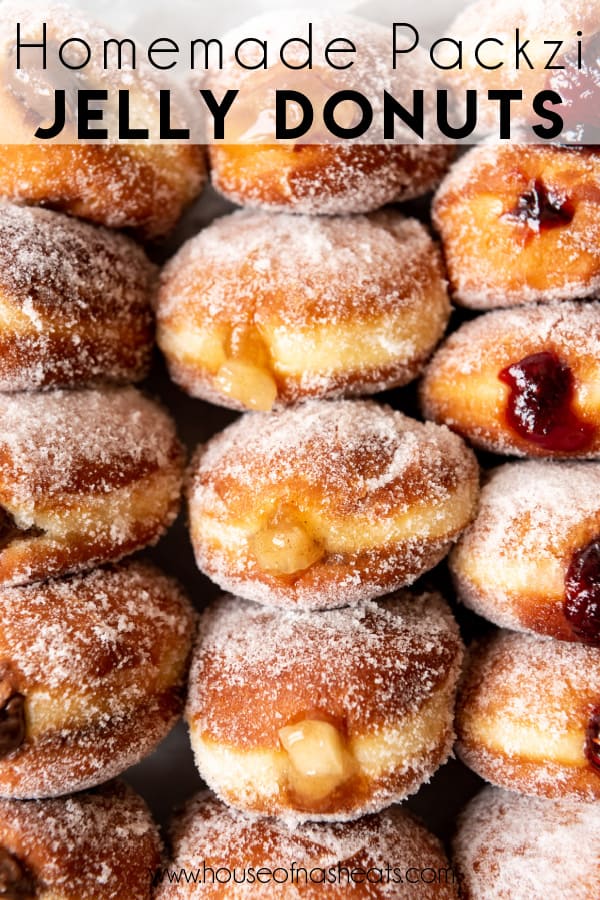
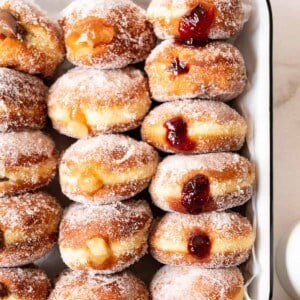
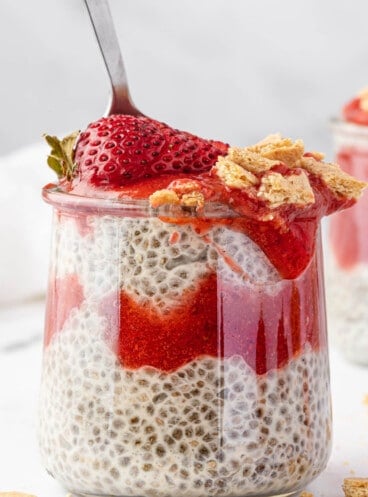
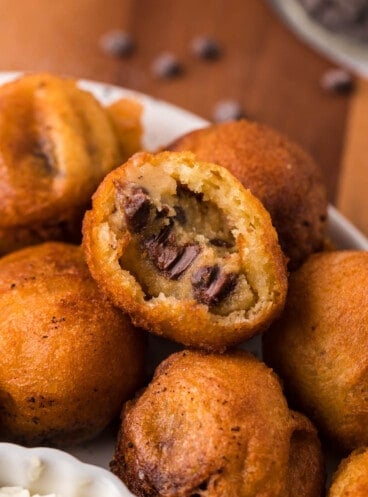
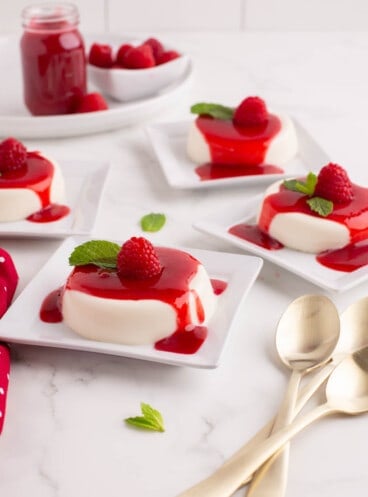
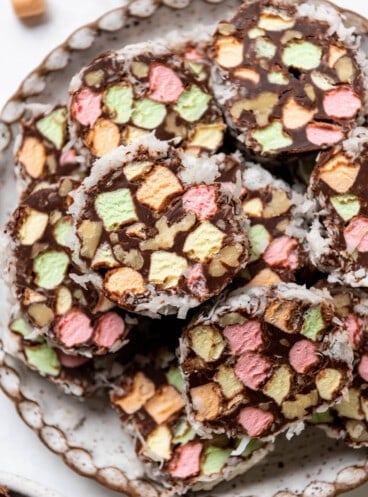

I have been making Paczki for many years and have tried at least a dozen recipes, but this recipe was the best and was outstanding! The dough rose very well, wasn't too sticky and fried up beautifully! I dipped them in regular sugar while still very warm and filled them with my homemade cherry jelly when they were completely cool. Excellent recipe, not too sweet and as soft as air. Will make again and not just on Fat Tuesday.
I'm so happy to hear you enjoyed them so much! The homemade cherry jelly sounds fantastic!
Paczki (POONCH-KEY) is the plural form and the correct pronunciation.
One is called a paczek (POON-chek).
Yes, I am Polish--all four grandparents born in Poland.
Thank you very much!
The only correct pronunciation is PONCH-kee (plural) and PON-check (singular) - that's obviously simplified version, because pronunciation of Ą is more nuanced than that. I know what I'm talking about, I live in Poland!
BTW - one ingredient from your recipe is missing. Alcohol! Poles uses rectified spirit - 95% of it is pure ethanol. Spirit is absolutely necessary in order to prevent the dough from soaking fat during frying. It's very small amount, but powerful and it makes a difference. Also in Poland we only use fresh yeast for pączki.
Thank you for your insight! I will have to try adding a little alcohol to the dough the next time I make these. I didn't realize it would prevent fat absorption during the frying process!
Great recipe. I tried multiple and this is the one that came out amazing. Took me back to my childhood in Poland.
Oh good! I'm glad this recipe could bring back those fond memories.
Pun ch ka is the correct way to say it. And my grandmother made these from scratch. But always made with left over mashed potatoes. So a potato fat biscuit is what was made. I do have the official recipe she used. And it did have mashed potato donut with the fruit filling and coated with sugar or powdered sugar. Or cinnamon and sugar.
Could these be made smaller, like 2”? I ask because I want to make for a competition so smaller would be better. I would fill with custard,
Oh yes they should be fine made into a smaller size. Good luck with the competition!
Not as as difficult as you might think to make. The doughnut had great flavor, very nice and airy texture. I tried Cherry and raspberry fillings (canned), I think next time I’ll make my own fruit filling.